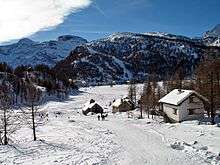Alpe Veglia and Alpe Devero Natural Park

The Alpe Veglia and Alpe Devero Natural Park was established in 1995 and is in the Ossola valley, in the Province of Verbania.
History
The hollows are geologically and mineralogically interesting, since they testify long period geological process: the presence of remainders of ancient glacier such as the Ghiacciaio del Leone, the Ghiacciaio d'Aurona dall'alpe Veglia or the Ghiacciaio della Rossa prove the glacial origin of the hollows.[1]
The mineralogy is interesting: there are asbecasite, cafarsite and cervandonite.[1]
Establishment of the park
The park has been established with the L.R. n. 32 on 14 March 1995 joining two already existing parks:
Alpe Veglia Nature Park
The Alpe Veglia Nature Park was the first regional park, established in 1978 (L.R. 14/78) on the Italian side of the Alpe Veglia at an altitude of 1750 m. It was 4120 hectares wide including the municipalities of Varzo and Trasquera, adjoining the Canton of Valais in Switzerland.
Alpe Devero Nature Park

The Alpe Devero Nature Park was established in 1990 (L.R. 49/90) in order to protect the alpine environment on the Italian side of the Lepontine Alps.[2]
The Alpe Devero is in the Baceno municipality.[3]
SCI and SPA
The Alpe Devero has been established as Special Protection Area (SPA) in the Natura 2000 network.[4]
Both Alpe Veglia and Devero have been proposed as Site of Community Importance in 1995.[5][6]
Territory
The area include two wide U-shaped valleys.
The Alpe Veglia is surrounded by Helsenhorn (3.272 m), Hillehorn (3.156 m), Bortelhorn (3.192 m), Punta d'Aurona (2.984), Wasenhorn (3.246 m) and monte Leone (3.553 m).[1] Every mountain has his ows glacier.
The Alpe Devero is surrounded by Ofenhorn (3.235 m), Albrunhorn (2.840 m), Punta Valdeserta (2.939 m), Punta della Rossa (2.888 m), Schwarzhorn (3.108 m), Scherbadung (3.155 m) and Pizzo Cornera (3.083 m).[1]
Municipalities
Flora
The flora is homogeneous, but the main tree is the larch. Throughout the whole park you can see larchwoods and some alderwood. Above 2000 m altitude there are mostly Rhododendron and dwarf shrub nourrishing insects such as honey bees, wasps, bumblebees and flies. It is possible to spot Picea abies, but they are very rare.
Fauna
The fauna of the park is mostly composed by typical alpine animals, such as steinbock, Red deer, Roe deer, chamois, fox, red squirrel, Eastern gray squirrel, Golden eagle, European badger and many others. In the lakes or rivers you can find different fishes such as trouts and graylings.
Activities
In winter it is possible to ski, Cross-country skiing and walk with snowshoes.
In summer there are many enjoyable walks and trekkings and you can also do climbing.

See also
References
- 1 2 3 4 "Rivista del Coordinamento Nazionale dei Parchi e delle Riserve Naturali", n. 10, novembre 1993, su www.parks.it.
- ↑ Bilancio per i 15 anni del Parco naturale dell'Alpe Devero Fonte: alpMedia.
- ↑ Territorio su www.alpedevero.it.
- ↑ Fonte: Regione Piemonte – Assessorato Turismo e Parchi.
- ↑ Fonte: Ministero dell'Ambiente.
- ↑ Rete Natura 2000- schede descrittive sintetiche dei Siti di Importanza Comunitaria, Regione Piemonte - settore pianificazione aree protette, 2007 (on-line in formato .pdf)
External links
Coordinates: 46°16′14″N 8°08′34″E / 46.2705°N 8.1429°E